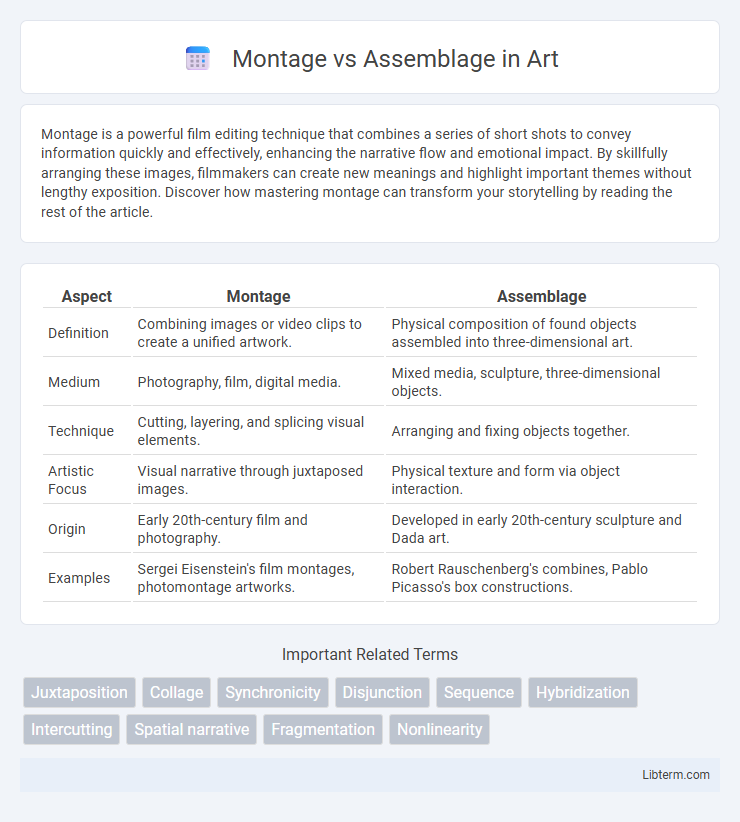Montage is a powerful film editing technique that combines a series of short shots to convey information quickly and effectively, enhancing the narrative flow and emotional impact. By skillfully arranging these images, filmmakers can create new meanings and highlight important themes without lengthy exposition. Discover how mastering montage can transform your storytelling by reading the rest of the article.
Table of Comparison
| Aspect | Montage | Assemblage |
|---|---|---|
| Definition | Combining images or video clips to create a unified artwork. | Physical composition of found objects assembled into three-dimensional art. |
| Medium | Photography, film, digital media. | Mixed media, sculpture, three-dimensional objects. |
| Technique | Cutting, layering, and splicing visual elements. | Arranging and fixing objects together. |
| Artistic Focus | Visual narrative through juxtaposed images. | Physical texture and form via object interaction. |
| Origin | Early 20th-century film and photography. | Developed in early 20th-century sculpture and Dada art. |
| Examples | Sergei Eisenstein's film montages, photomontage artworks. | Robert Rauschenberg's combines, Pablo Picasso's box constructions. |
Understanding Montage and Assemblage
Montage and assemblage are both artistic techniques that involve combining various elements, but montage primarily refers to the editing process in film and photography where multiple images or shots are juxtaposed to convey a specific meaning or narrative progression. Assemblage, rooted in visual arts, involves physically assembling disparate objects or materials into a cohesive three-dimensional composition, emphasizing texture and spatial relationships. Understanding montage requires grasping how temporal and visual sequencing creates meaning, while assemblage demands recognizing the significance of materiality and object interplay in form and concept.
Historical Origins of Montage and Assemblage
Montage originated in early 20th-century Soviet cinema, pioneered by filmmakers like Sergei Eisenstein who used rapid, rhythmic editing to create emotional and intellectual impact. Assemblage emerged as an art form in the early 20th century, rooted in Dada and Surrealism movements, where artists like Pablo Picasso and Georges Braque combined found objects to create new visual narratives. Both techniques fundamentally transformed their respective mediums by emphasizing the juxtaposition of disparate elements to generate novel meanings.
Key Principles of Montage
Montage emphasizes the juxtaposition of individual shots to create new meanings beyond the sum of parts, relying on principles such as metric, rhythmic, tonal, overtonal, and intellectual montage to evoke emotional and cognitive responses. It manipulates time and space by editing disparate images in a deliberate sequence to generate narrative tension and symbolic resonance. Assemblage, in contrast, aggregates elements without necessarily altering their intrinsic meaning, focusing on the collective presence rather than transformative synthesis.
Core Concepts of Assemblage
Assemblage theory centers on the dynamic relationships between heterogeneous elements that form complex systems, emphasizing contingency, emergence, and the capacity of components to both connect and detach. Unlike montage, which primarily organizes parts for aesthetic or narrative purposes, assemblage highlights the fluidity and multiplicity of connections that generate new properties through interaction. Core concepts of assemblage include territorialization, deterritorialization, and reterritorialization, reflecting how assemblages stabilize, destabilize, and reorganize over time.
Visual Techniques in Montage vs Assemblage
Montage employs rapid, dynamic editing to juxtapose images and create a narrative or emotional impact, emphasizing temporal and spatial relationships between shots. Assemblage, by contrast, integrates multiple visual elements within a single frame or space, highlighting texture, depth, and materiality through physical layering and three-dimensional composition. Both techniques exploit visual juxtaposition but differ in temporal manipulation and spatial arrangement to convey meaning.
Major Artists and Movements
Montage is prominently associated with Soviet filmmakers like Sergei Eisenstein, who utilized it to create ideological and emotional impact through dynamic editing in the 1920s, while Assemblage roots itself in the work of artists such as Pablo Picasso and Marcel Duchamp, who pioneered the use of everyday objects in art within the Cubist and Dada movements. Key movements linked to Montage include Soviet Constructivism and the broader avant-garde cinema, whereas Assemblage is fundamentally tied to mid-20th-century art movements like Neo-Dada and Abstract Expressionism, with artists like Robert Rauschenberg and Louise Nevelson advancing its development. Both methodologies revolutionized visual art and cinema by emphasizing the construction of meaning through the arrangement of disparate elements, but Montage operates primarily in film editing, while Assemblage manifests in sculptural and mixed media works.
Narrative Impact: Montage vs Assemblage
Montage uses sequential shots to create a unified narrative that emphasizes thematic progression and emotional resonance, leveraging temporal juxtaposition to shape audience interpretation. Assemblage combines disparate elements and sensory inputs in a non-linear fashion, fostering multi-layered meanings and open-ended narratives that invite subjective engagement. The narrative impact of montage lies in its ability to guide viewer understanding through constructed continuity, while assemblage challenges traditional storytelling by promoting fragmented, interpretive experiences.
Applications in Contemporary Art
Montage in contemporary art involves the combination of diverse visual elements, such as photographs or film frames, to create a cohesive narrative or thematic expression, commonly seen in video art and digital collages. Assemblage incorporates three-dimensional objects and found materials to construct sculptural works that challenge traditional notions of art by emphasizing texture, space, and materiality, frequently used in installations and mixed-media projects. Both techniques highlight artists' exploration of fragmentation and juxtaposition, with montage emphasizing temporal sequencing and assemblies focusing on spatial interaction.
Comparing Emotional and Conceptual Effects
Montage creates emotional intensity by juxtaposing disjointed images, prompting viewers to infer meaning through contrast and rhythm. Assemblage combines physical elements into a cohesive whole, evoking conceptual depth by uniting disparate materials into a singular narrative. Both techniques engage audiences differently: montage stimulates cognitive engagement through visual sequencing, while assemblage invites contemplation of tangible, symbolic relationships.
Choosing Between Montage and Assemblage in Creative Practice
Choosing between montage and assemblage in creative practice depends on the desired narrative impact and materiality. Montage emphasizes the juxtaposition of disparate images or scenes to create new meaning through editing, ideal for storytelling and temporal flow. Assemblage involves physically combining varied objects or materials, enhancing tactile dimension and spatial relationships, suitable for three-dimensional exploration and material symbolism.
Montage Infographic

 libterm.com
libterm.com